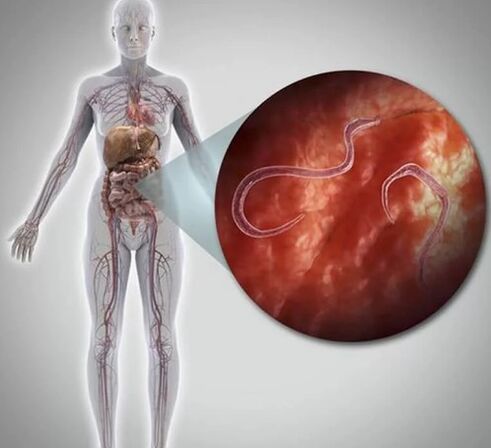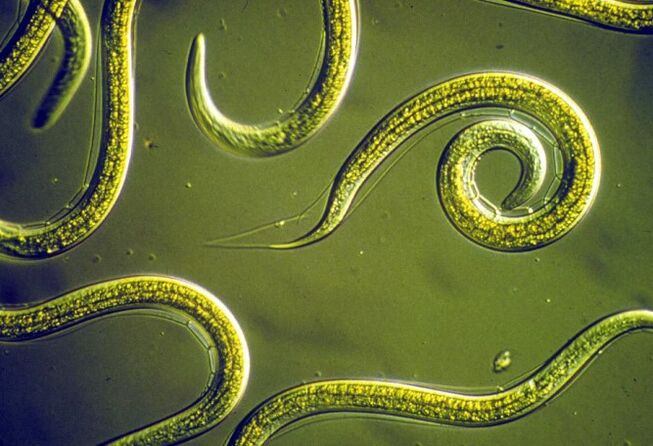Human parasites are parasites whose infection is subject to a person. The general definition of the word "parasite" applies not only to mult cells and protozoa who live at the expense of their owner and to the disadvantage of the latter, but also on viruses, bacteria and fungi with similar properties. According to the historical tradition and from the point of view of medical parasitology, it is common to designate all creatures that lead a parasitic lifestyle, with the exception of viruses and bacteria with similar properties.

The parasites include many helminths, fungi, viruses, protozoa, worms, crustaceans, spider luggages and insects. The owners of parasites can be bacteria, simplest, plants, animals and humans. Parasites are subject to a complex development cycle: Sometimes you need a change from 2-3 owners whose bodies (helminths pass the larval stages) or permanently (helminths are invasive).
From the story:
The examination of parasites in the elderly is based on the examination of feces and other petrified material. The earliest parasites found in humans were paragonimus westernmani egg from northern Chile, discovered in the hardened feces and dates about 5900 BC. Chr. E. In Brazil, hook worm eggs of 5000 BC. Chr. Found. In Peru - Nematod -egg from 2330 BC. Chr. E. And the Egyptian mummies from 2000, 1250 and 1000 years. Bc. e. They contained a solitary together with a well -preserved female worm.
In Berlin for the period 1866-1875. 16% of all open corpses contained worms of worms. Bull Taferly (Taeniarhynchus Saginatus) was particularly widespread when the raw beef meat was eaten. In St. Petersburg, according to Kessler 3, 66 % of the people he examined suffered from this parasite (1888). Pork tieben (Taenia Solium) is located everywhere in areas where you eat raw or semi -shot pork. In St. Petersburg, around 3 % of the population suffered from this parasite at the end of the 19th century. When they started to avoid the use of raw meat, the percentage of diseases, for example, has dropped from 53 % to 20 % in Denmark for 10 to 12 years. Dypilidium caninum lives in the intestine of dogs and cats and rarely in the intestine of children. Cases of infections of children at the end of the 19th century were from England, Germany, Denmark: infection only occurs when fleas were swallowed.
Parasites and their discharge(Products of your life) are the strongest poisons for the human body. They cause severe acidification and thickening of blood and the entire inner environment. They provoke the most serious health disorders. From bronchitis to oncology. Destroy a person's psyche, deprive of peace and sleep. In the child's body, parasites prevent the normal development of the child's nervous system and contribute to mental and physical backwardness with a long current illness.
classification
By distribution:

- Ubiquette - meet everywhere.
- Tropics - distributed in tropical climate zones.
About biological and epidemiological features:
- Geohelminths are an illness in which helminths first develop in the human body and then on the ground on earth.
- Biohelminths are an illness in which a biological cycle of helminth development must take place in the body of other living things with the exception of a person. Differentiate between the last owners, in whose bodies, helminths develop for sexually mature and intermediary level, whereby the parasite is located in the stadium of the larva or its reproduction is not sexual. One person is more often the last owner, less often - medium.
- Contact helminthiasis is an illness in which parasites mature or ripe from the human body, whereby the infection of another person is possible or is infected again (automatic invasion, new invasion).
Depending on the localization of the parasite in the body:
- Enlightenment - life in the cavity of the intestine and other cavities of a person (e. g. Ascarides, ligaments).
- Fabric - live in fabrics (sistematis, ehinococcoz).
At the site of the owner:
- External: Mosquitoes, blind, leech, lice.
- Internally(Helmintias):Round worms(Nematoden - Ascarids, Filaria, Vlasov, Pinworms, Strunggyloid, Ancylostomidae, Trichinella);Flat worms:
- Trematodes (Stertasts - Katzenbickelter (Opisthorchis), Kloner, Fasciola, Schistosomen);
- Cestoden (tapeworms - bull and pork tapeworm, dwarf flowers, wide adhesive tape, Echinococcus).
- Bacteriosis(Leptospira, Staphylococcus, Streptococcus, Shigella).
- Protose(Amöben, Giardia, Trichomonas, often the owners of the Chlamydi and AIDS virus).
- Mycosis(Fungal diseases) - Candida, Cryptococcus, Penicillium.

How do parasites enter the body?
Parasitism can not only be infected by dirty hands. Animal hair is a carrier of worms (Ascarid and Toxocara), Lamblia. Eggs with pinworms that fell out of wool stay up to 6 months and dust, toys, carpets, underwear and bed linen and hands in the food tract. A dog through wet breath movement distributes eggs at a distance of 5 meters (cat - up to 3 meters). Dog flies also tolerate worm eggs. Askarid eggs enter the body through poorly washed vegetables, fruit, berries, green, dirty hands and are also spread out on flies. And incorrectly cooked barbecue or homemade lard is the infection path with trichinellosis; Bad salted fish, caviar - opisthorchiasis and wide adhesive tape.
So there are different ways to enter the body:
- Digestible (by infected food, water, dirty hands);
- Contact-household (through household items of infected family members, pets);
- Transferable (by blood -sucking insects);
- percutaneous or active (in which the larva penetrates through the skin or mucous membranes while bathing in open reservoirs during contact with infected soil).
Symptoms of parasites
It is not necessary at all that the infection somehow manifests itself. Sometimes, despite the invasion, a person feels healthy thanks to the strong immunity. He will be healthy for a few individual times. Accordingly, the extinction of immunity (a breakdown can be stress, surgery, illness) - calm signals parasites are still beginning to serve. This is a urine with smell, acne on the skin, stubborn cough with clean lungs, unstable chairs with sharp smell or constipation, gas formation and unpleasant smell from the mouth. The most specific manifestation of the presence of helminths in the body is bruxism (night -road of the teeth). Night palel, the usual nausea, the perversion of the appetite of the night hunger, the tireless hunger, addiction to sweet and acidic food and airfingles. Children have a decline in appetite or electoral appetite. Sometimes people with an increased appetite are found, but at the same time they lose weight.
General signs of parasitic invasions
Constipation, stagnation of Galle

Due to their shape and large sizes, some worms can mechanically close the lumen of the intestine, the channels of the bile tract, which leads to a deterioration in peristalsis, the formation of constipation, full or partially intestinal deflection. HLYBON invasion can provoke the blockade of the common bile duct, which leads to difficulties in the drainage of gall, mechanical jaundice.
Diarrhea
A number of parasites, especially protozoals, produce substances such as prostaglandins that lead to sodium and chlorides, which in turn provokes frequent watery intestinal movements through diarrhea.
Gastric and intestinal complaints syndrome
The parasites living in the upper intestine cause inflammation and lead to a disturbance of the intestine that flows up. This leads to a decrease in the absorption of nutrients. As a result, fats that should be absorbed in the small intestine fall into the large intestine and provoke cramps, alternating constipation and diarrhea.
Joint pain and muscles
Parasites can move around the human body, for example to settle in the articular fluid and in the muscles in the most convenient places. Feature inflammation is the result of the violation of parasites or the body's immune response to your presence. At the same time, a person experiences muscle and joint pain.
allergy
Parasites can disturb the normal permeability of the intestinal mucosa, which increases the risk that large, untracted food particles penetrate it. This activates the body's immune response - the level of the eosinophilic - protective blood cells in our body, which contribute to the development of allergic reactions. Parasites cause increased production by the body of immunoglobulin E, which improves allergic reactions.
Problem skin
Darmparasites can cause allergic skin reactions - atopic dermatitis, urticaria, eczema. In most cases, inflammatory changes on the skin can be the result of protozoen microorganisms (lamblia, mushrooms) and opisthorchis.
Change body weight
Weight fluctuations (both as normal and less) can be attributed to a parasitic disease. Weight reduction is due to the fact that digestion in the body is impaired because there is an "inner consumer". Obesity is also a consequence of the "robbery" of the human body with helminthian invasion. The feeling of hunger occurs due to the activity of helminthen, its toxic effects on the body, with a strong drop in blood sugar.
anemia
Many types of intestinal helminths are attached to the intestinal wall, damage them and cause a sufficiently greater blood loss, which leads to anemia.
Nervousness, sleep disorder
The toxic substances of vital activity of parasites stimulate the central nervous system and cause increased fear and nervousness. The frequent awakening in the middle of the night, especially between 2 and 3 hours, is also the result of the body's experiments to get rid of poisonous substances through the liver.
"Chronic fatigue syndrome"
The "chronic fatigue syndrome" includes weakness, causal acceptance and fever, emotional instability, loss of concentration and bad memory. These symptoms can be the result of anemia, poisoning and a nutrient caused by parasites in the body.
After discovering their family members of several symptoms, the diagnosis of parasitism underwent and carry out a preventive treatment of deworming.

Diagnosis
In recent times, the presence of parasites has only been determined by the method of duodenal sounding and feces tests using microscopic examinations, the purpose of which is to prove selected helminths or their fragments, eggs and larvae. Eggs and larvae of helminthen parasitic in the liver, bile paths, pancreas and duodenum were found in biliary and duoden-enamel holding; They examined samples from Kot on the intestinal forms of helminthia; In the event of suspicion of Paragonimoz, Sputum was examined and urine urine was on the genitarian chistosomosis. However, the reliability of these studies depends on the professionalism of the employees - regardless of whether the laboratory assistant is noticed when the microscopic examination of parasites. If the parasite has not currently shifted the eggs when the check is carried out, its presence will be unnoticed even with high qualifications of the laboratory assistant. Often you can only achieve a positive result with 8 to 10 attempts.
Today there are immunological studies that enable them to determine the presence of antigens and antibodies in parasites of various kinds in the blood of an infected person. The reliability of such analyzes depends on the life cycle of parasites and their amount in the body.
Children are most susceptible to the effects of parasites. They are infected with different types of parasites by dirty hands, sand, soil and water. Sometimes the child's infection can occur in intrauterine, since the simplest bacteria, viruses, candida and helminthen larvae can penetrate through the placenta with blood flow and during birth through the placenta.
If you do not risk the health of your children, carry out preventive deworming courses.








































